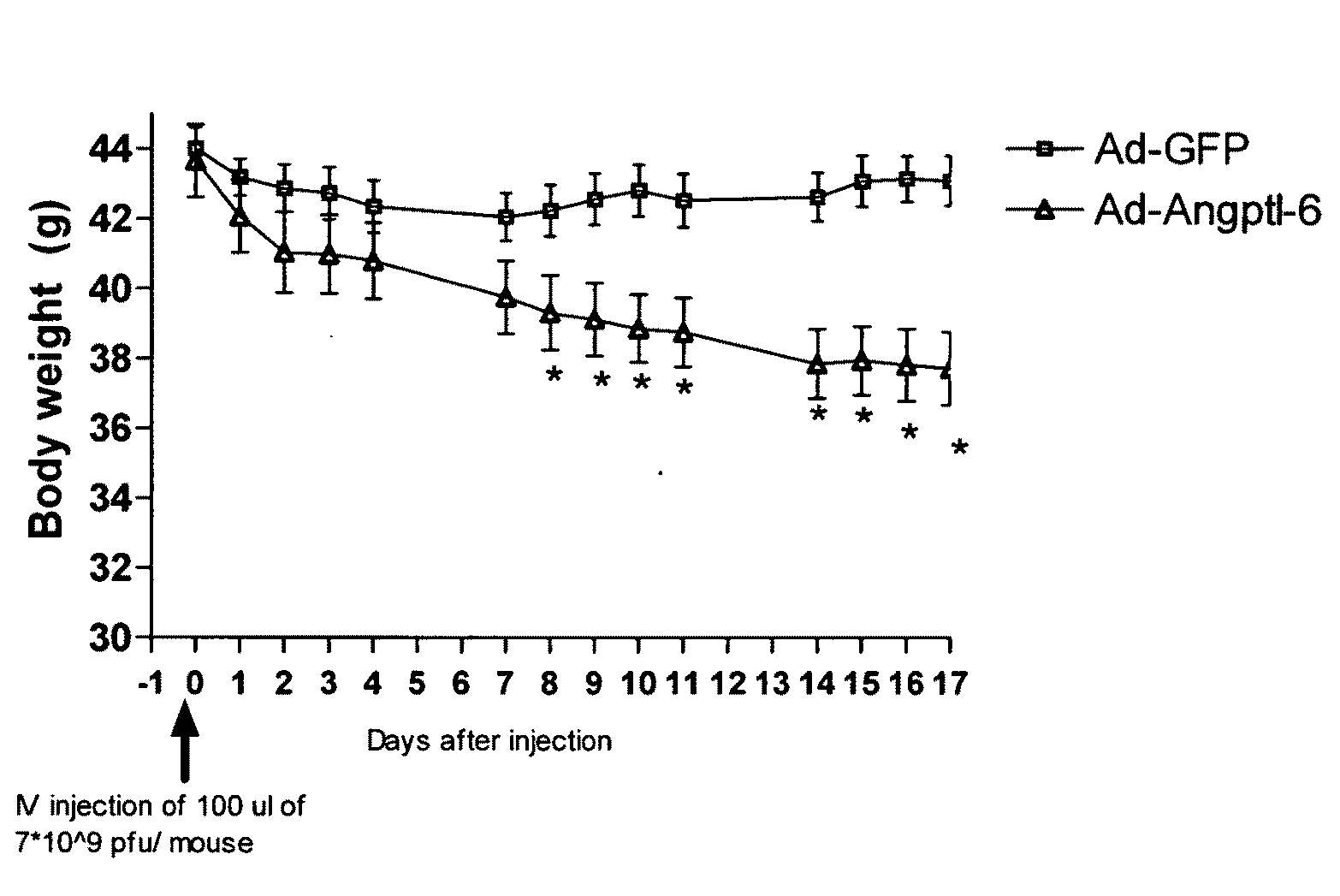Peptide compounds for treating obesity and insulin resistance
a technology of angiopoietin and peptides, which is applied in the direction of transferrins, angiogenins, metabolism disorders, etc., can solve the problems of angiogenesis and an unacceptable effect of antiobesity treatment, and achieve the effect of reducing obesity and insulin resistan
- Summary
- Abstract
- Description
- Claims
- Application Information
AI Technical Summary
Benefits of technology
Problems solved by technology
Method used
Image
Examples
example 1
[0082]In this example, adenovirus (Ad) overexpressing full-length Angptl6 or N-terminus portion of the protein (containing the coiled-coil domain) were constructed and tested in vivo.
Recombinant Adenovirus Preparation:
[0083]Angptl6 full-length protein (Angptl6) and the N-terminus Angplt6 (NAngptl6) peptide were PCR amplified using the full-length cDNA encoding Angptl6 (Invitrogen) as template. PCR fragments were sub-cloned into the Gateway entry vector pENTR1A (Invitrogen) containing the CMV promoter to generate Pterm-Angptl6 and Pterm-NAngptl6 clones. These PCR primers were used to generate a DNA encoding the full-length Angptl6 protein: FORWARD: TCAGGATCCGTGGGATTGCCGCAAACCTC (SEQ ID NO:11); REVERSE: AGCTGAAGGAGATAGGAACA (SEQ ID NO:12). These PCR primers were used to generate DNA encoding the NAngptl6 peptide: FORWARD: TCAGGATCCGTGGGATTGCCGCAAACCTC (SEQ ID NO:13) and REVERSE: GGTGCTCGAGTCAAGAAGATGGAGGCCCCTGCTG (SEQ ID NO:14).
[0084]In order to generate the recombinant adenovirus vec...
example 2
[0093]The N-terminal domain of Antptl6 can also be fused at either end to a peptide tag such as a Flag tag or hexahistidine tag to aid in purification and detection of the recombinant protein. The protein can be expressed in E. coli, yeast (such as Pichia pastoris or Saccharomyces cerevisiae), or mammalian cells.
[0094]A fusion protein can also be made with mouse or human Angtpl6 peptide fragments and the Fc region of human or mouse IgG top be expressed in mammalian cells. Such a fusion will extend the serum half life of the administered protein. The fusion may be placed at the N or C terminal of the N-terminal Angptl6 peptide and may contain a linker or “hinge” amino acid sequence. For human Angptl6, the N-terminal Angptl6 domain contains either 1-240 or 1-217 amino acids; for mouse Angptl6, 1-227, or 1-204 or 25-227. The Fc moiety can be derived from mouse IgG1 or human IgG2M4. The secretive leader sequence can be the original (in the case of those constructs that start with amino ...
example 3
[0097]A DNA sequence (SEQ ID NO:7) encoding a mouse Angtl6 peptide fusion protein with a hexahistine tag at the N-terminus may be prepared by PCR amplification of mouse angptl6 cDNA obtained from a commercial vendor using primers with Nde1 (SEQ ID NO:8) and Xho1 (SEQ ID NO:9) restriction sites attached. The DNA is cut with Nde1 and Xho1 and ligated into plasmid pET28b (Novagen) such that the expressed Angptl6 peptide fusion protein had the amino acid sequence shown in SEQ ID NO:10, including a N-Terminal histidine tag.
[0098]An E. coli strain such as BL21 (DE3) pLysS is transformed with the plasmid using standard methods. The transformed E. coli are grown in Terrific Broth (Teknova) at 37° C. to an optical density between 0.6 and 1.0 at 600 nm and then induced with IPTG. The cells are allowed to grow for three more hours and then harvested by centrifugation. The cells are lysed by three freeze thaw cycles followed by the addition of lysozyme (60,000 units / gram of cells, Epicentre Bio...
PUM
| Property | Measurement | Unit |
|---|---|---|
| metabolic disorder | aaaaa | aaaaa |
| resistance | aaaaa | aaaaa |
| density | aaaaa | aaaaa |
Abstract
Description
Claims
Application Information
 Login to View More
Login to View More - R&D
- Intellectual Property
- Life Sciences
- Materials
- Tech Scout
- Unparalleled Data Quality
- Higher Quality Content
- 60% Fewer Hallucinations
Browse by: Latest US Patents, China's latest patents, Technical Efficacy Thesaurus, Application Domain, Technology Topic, Popular Technical Reports.
© 2025 PatSnap. All rights reserved.Legal|Privacy policy|Modern Slavery Act Transparency Statement|Sitemap|About US| Contact US: help@patsnap.com



